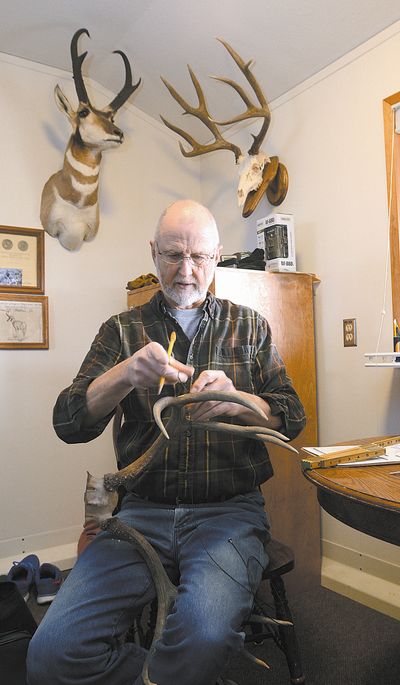Scoring big game starts with symmetry

People have a fascination with comparing and contrasting and, most of all, ranking.
It’s what makes stats so important to sports like baseball. Fans can compare players across eras. Hank Aaron has the most (non-steroid-aided) home runs. Pete Rose is the hits king.
Some hunters and anglers are no different. They want to rank their catches and harvests.
When it comes to fishing, it’s somewhat easy to judge the greatest catches. In most cases, fish are measured by weight, with the heaviest fish of a particular species being the winner. But big game hunting is a different matter. Instead of weighing an animal, hunters judge quality by their antlers and horns. But how does one measure an elk or deer rack?
It’s a complicated process invented in 1950 by the Boone and Crockett Club, and later adopted by other organizations like the archery hunting group Pope and Young.
For species like deer and elk, several measurements are taken to the eighth of an inch, including the length of the main beams of each antler, the length of each point, the width of the inside spread between the antlers’ main beams and the circumference of the antlers at four spots.
All of those measurements are added up for a net score. The final score is determined by symmetry. Scorers compare each of the measurements from one side of a rack to the other and subtract the differences. For instance, if the main beam on one side of an elk rack is 51 inches and the other side is 52, there is a one point deduction. To arrive at a final score, all of the deductions are tallied and subtracted from the net score.
“The whole system is set up on symmetry,” said Sam McNeill, a semiretired employee of the Idaho Department of Fish and Game, who has been a certified Boone and Crockett scorer for 44 years.
The length of points and the circumference or mass of the antlers also ranks high in scoring.
“Before I started scoring, I was always looking for the widest buck I could find,” said Sam Wilkins of Clarkston, who is certified to score for Boone and Crockett, Pope and Young and Northwest Big Game Inc., which publishes record books specifically for Oregon, Washington, Idaho and Montana. “Now after doing this for 13 years, I like height and mass more than wide. But some bucks have it all. Those bucks are high up in the record books.”
Deer, elk and other antlered animals with nontypical antlers – those with a large number of abnormal or nontypical points – are scored differently and judged in their own category.
Predators, like mountain lions and bears, are measured by their skulls.
Both Boone and Crockett and Pope and Young publish record books. To make the books, hunters must have taken an animal that meets minimum criteria for a particular species.
For Boone and Crockett, the club publishes an “Awards Book” every three years. All animals that qualify are published in the book. The “Awards Book” starts with a clean slate every time it is published, meaning a certain animal will only appear in a single edition of the book.
The club also publishes an “All Time” book every six years. It has higher minimum scores. Each animal that meets the criteria is published in the “All Time” book. But unlike the award book, animals that meet the “All Time” requirements are published in each additional edition.
Making either book is difficult.
“It takes a dandy to be there,” Wilkins said.
To have their names published in record books, qualifying hunters have to submit an application as well as a fee. The record organizations make money through the fees as well as sales of the books.